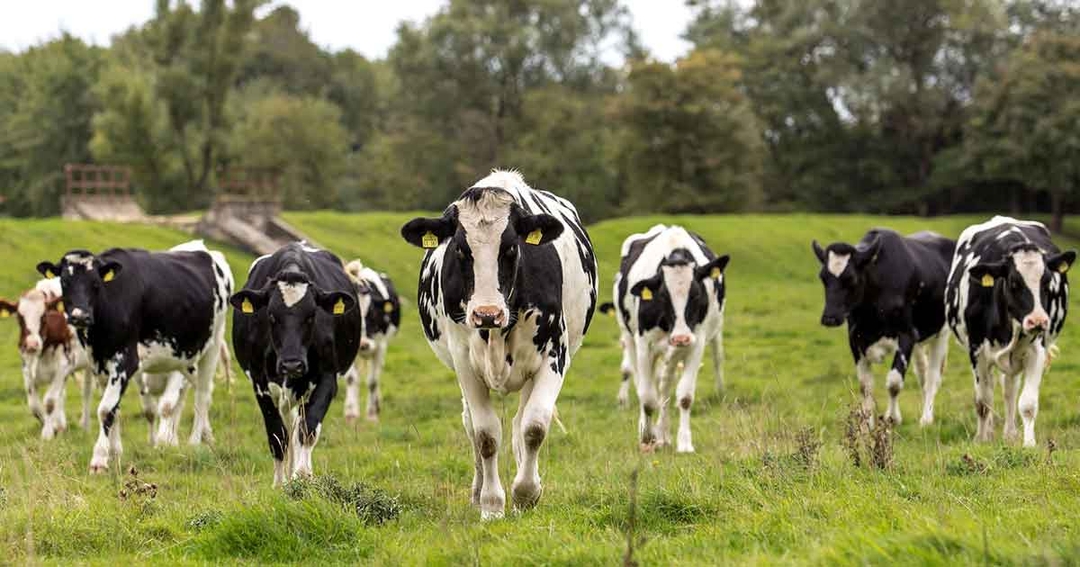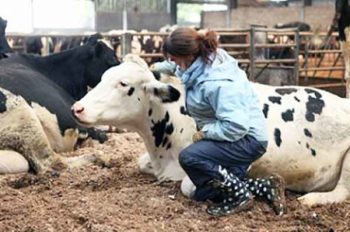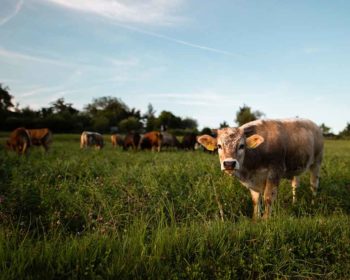30 Jun 2021
Helen Lambert MSc, BSc(Hons), MSB suggests techniques to make human-cow interaction safer and minimise any animal distress, citing research and taking into consideration their natural tendencies.

Image: © Rokfeler / Adobe Stock
A calm cow that is content and not stressed is desirable for the vet, the farmer and the cow.
Veterinary examinations and procedures can be a stressful experience for cows, as well as the people involved, if the cow is restless and unsafe.
The exposure to an unfamiliar person, being isolated from their peers, as well as the experience of the procedure itself can all result in a stressed and anxious cow, and for calves and heifers the experience can make them more fearful of future interactions, and harder to handle.
A wealth of research is out there that can be used to make human-cattle interactions safer, and to minimise the amount of distress caused to the cows.

Any reduction or avoidance of stress levels can have significant benefits for the cow’s welfare, and the positive effects on the cow’s behaviour makes any interactions with the cow easier and more efficient. For example, the presence of an aversive handler has been shown to negatively affect the milk yield and heart rate of dairy cows (Rushen et al, 1999).
Rushen et al (1999) looked at whether dairy cows could recognise people and whether their fear, or lack of fear, had any effect on their milk yields, heart rate and behaviour during milking sessions. Two people handled the cows for five days – one gently and the other aversively. Each handler wore a different colour for the handling treatments.
Following the five days of treatments, the cows were tested to determine how well they could distinguish between the two handlers when the colour of their clothes had been changed. Most, but not all, of the cows could tell the handlers apart in their neutral clothing.
After the cows had each undergone the handling sessions, their behaviour, milk yield and heart rate were observed during milking sessions when either one of the handlers was standing in front of them. The presence of the gentle handler had no impact on the cow’s milk yield or residual milk. However, the presence of the aversive handler significantly affected the cow’s residual milk, causing an increase of 70% compared with the control and gentle handler sessions.
In the cows that could discriminate well between the handlers, the aversive handler’s presence also caused an increase in heart rate and movement, compared with the gentler handler and the control milking sessions.
For those cows that could not discriminate well, the presence of either handler caused an increase in heart rate and a decrease in movement, compared with the control sessions when no handlers were present.
It therefore appears that most cows can discriminate between relatively unfamiliar people, as both handlers were new to the cows. However, it is important to note that for the cows that could not discriminate, the interaction with any handler – gentle or aversive – caused an increase in heart rate and movements, suggesting their fear of the aversive handler supplanted any positive interactions they received.
This has implications for veterinarian interactions with cows. Often, the procedures by their nature may be unpleasant for the cows, but if they are carried out by a gentle handler, this will have less of a negative impact on the cow’s welfare than if the cows are handled aversively.
In addition, any aversive handling may have an impact on future interactions, as aversive handling has been shown to induce stress behaviours and physiological measures in unrelated contexts, such as during a milking session (Rushen et al, 1999; Figure 1).
Positive, gentle handling is a powerful tool not only in improving the cow’s welfare, but also in improving the experience and safety of human-cattle interactions.
Waiblinger et al (2004) found in their study that 10 five-minute sessions of positive treatment (gentle stoking, talking and hand-feeding concentrates) over a period of four weeks was enough to have significant positive effects on the behaviour and heart rate of dairy cows during veterinary procedures.

Each cow underwent nine minutes of veterinary handling, including four minutes of rectal palpitation and sham insemination. During this time the cow was either accompanied by the gentle handler, an unknown person, the usual caretaker, or was alone. The caretaker had no previous negative interactions with the cows, only positive ones, and was reported by his superiors as being a calm handler.
The caretaker, handler or unknown person stood beside the cow’s shoulder and attempted to calm her with positive interactions – such as stroking her neck and head, and speaking to her in a soothing manner – throughout the veterinary procedure (Waiblinger et al, 2004).
Unsurprisingly, the cows were the least stressed when the gentle handler was present, and this had a positive effect on both their behaviour and heart rate. The cows were less restless, kicked less and performed more positive interactions with the handler (neck stretching and leaning against the handler).
In addition, the cows’ heart rate was lower when the gentle handler or caretaker were present, compared with when they were alone or with the unknown person.
What is particularly interesting is that the cows generalised the positive handling experience to all humans to some extent. Although not as strong, the presence of any person had a positive effect on the cows’ behaviour, compared with the controls that had received no positive handling.
Even when they were alone, the cows that had previously experienced the gentle handling still showed a better response to the treatment, compared with the controls that had not received any such treatment. This suggests that positive previous experience of humans can have an influence on how confident and fearful cows are around humans, and directly affect their experience of human interactions (Waiblinger et al, 2004).
This, in turn, can make human-cattle interactions safer, as restless behaviour and kicking is reduced, and the experience is less stressful for the cows. However, as discussed earlier, any positive treatment can be overruled if the cows undergo regular negative interactions with a person, as this treatment can make the cows more fearful of any humans, regardless of any positive interactions they may also receive (Rushen et al, 1999).
Often, cattle are socially isolated when they are undergoing veterinary procedures or examinations. For a social species, such isolation can be particularly stressful (Forkman et al, 2007). Restrained heifers, for example, will struggle, vocalise, and have an increase in heart rate and plasma cortisol concentrations when their peers are removed (Boissy and Le Neindre, 1997). Whereas, when their peers are reintroduced, both the behavioural and cardiac effects significantly diminish.
In Boissy and Neindre’s study, they found that even just the sight of familiar or unfamiliar heifers was enough to reduce the negative effects of social isolation in the restrained heifer.
We humans rely a lot on social support, and it has important, positive effects on our health and our ability to cope with stress (Rault, 2012). There is still much to learn in non-human animals, yet it shows great promise as a tool for improving welfare. In calves, the presence of another calf can reduce the negative effects of separation stress when they are removed from the group (Jensen, 2006).
In one study, calves were first subjected to a social preference test where they could choose between a familiar and unfamiliar calf in a Y-maze, and then a separation test where they were removed from their home pen (Jensen, 2006). In the separation test, the calves were placed into an unfamiliar pen – once with a familiar calf, once with an unfamiliar calf and once on their own.
The calves preferred the presence of the familiar calf the most, but preferred the presence of any calf to being alone. When they were alone they vocalised more, showed less locomotor activity, more immobility and less exploration, compared to when they were separated with a companion calf. They vocalised the least when they were separated with the familiar calf, suggesting that the familiarity of the companion calf had a positive effect on their reaction to being separated from the group.
These findings have important implications in practice, as calves are often separated and housed alone. In addition, they may be separated from their peers for procedures such as disbudding.
If they can be kept with a familiar peer for as long as possible – or even better, not separated from them at all – then this may have a significant positive impact on their psychological welfare.
As discussed previously, even visual access can make a valuable difference and may be a suitable alternative if physical access is not feasible (Figure 2).
The number of peers, along with familiarity, can also have a positive effect of reducing stress levels in cattle. Japanese black heifers were found to be significantly calmer during various stress tests when they had a familiar peer with them (Takeda et al, 2003). The presence of four familiar peer heifers had an even stronger effect – not only on their behaviour, but also on their cardiac response.
In fact, the change in the heifers’ heart rate in response to two stress tests was minimal when they were in a group of five heifers. This suggests that both familiarity and the number of peers can have a positive buffering effect against negative stress in cattle (Takeda et al, 2003; Figure 3).
Cattle are highly motivated to seek out other cows after they have been socially isolated. Understanding this can help to moderate the stressful experience of social isolation and not perpetuate it beyond what is necessary.
In one study, Angus heifers were restrained and socially isolated for two minutes (Ishiwata et al, 2007). Afterwards, they were given a choice of two pens to access, from a combination of:
The heifers chose the peer pen more often than the food or bare pen. They would also make their choice faster when the peer pen was one of the options.
A second group of cows were also restrained and then given the choice of accessing one of two pens after their release. The two pens were a combination of:

The heifers tended to avoid the pens with the handler, with most choosing the novel object over any of the handler options. This suggests that the cattle were highly motivated to avoid any further handling after their restraint treatment (Ishiwata et al, 2007).
If we can consider this in practice by avoiding approaching previously restrained cattle, this knowledge can serve to reduce the negative effects of veterinary procedures on the mental well-being of cattle (Figure 4).
The dairy industry has never been under such scrutiny from the British public as it is today. Common practices are often viewed as cruel and unnecessary. In the UK, a strong movement exists towards free-range dairy practices and the launch of a free-range milk label (Free Range Dairy) has brought the issue even more into the public eye.
Any measures that can be taken to improve the welfare of dairy or beef cattle are a positive step forwards. Numerous ways exist in which this can be done, and the author has discussed some of them in this article.
As always, discussion and collaborations are what are key, and new research is always being conducted to move our learning forward – and with it comes new ways to improve the lives of the animals in our care.